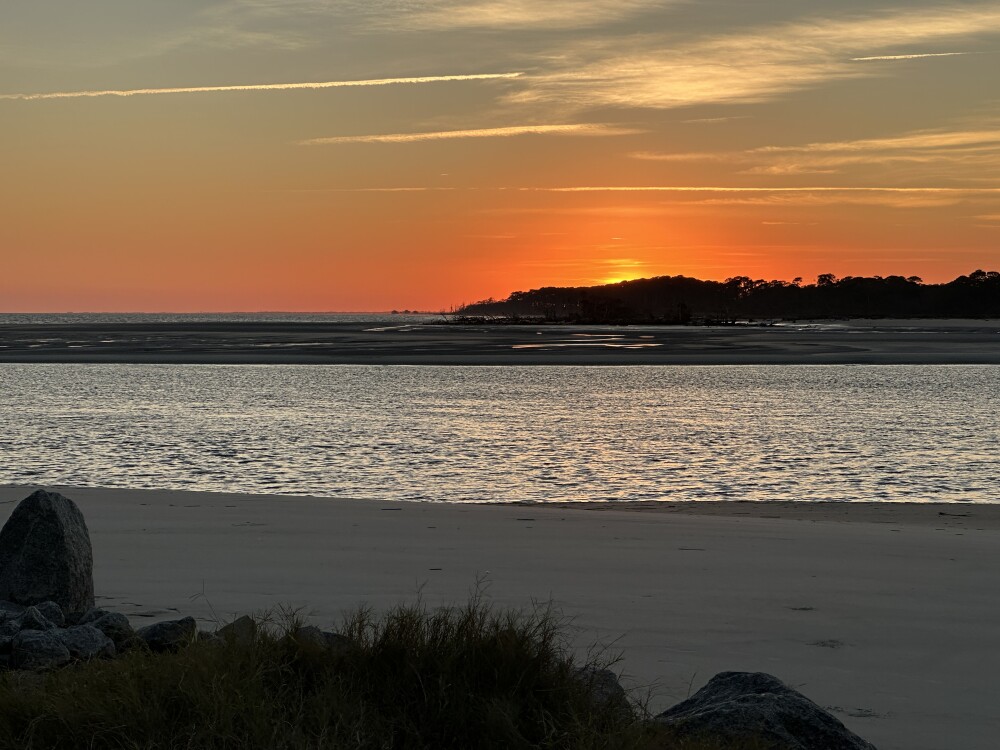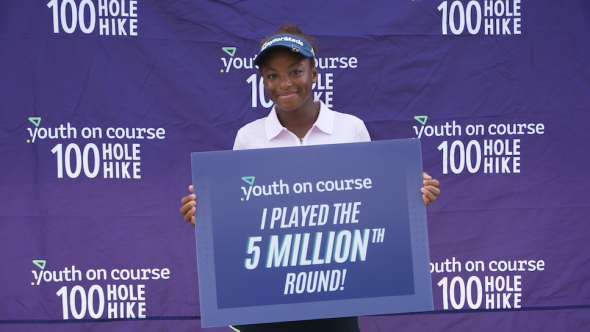FRIPP ISLAND, S.C. – You don’t get here by accident.
Even with Waze as my guide and my wife and daughter snoozing in the car behind me, I felt the slightest uncertainty over where I was going. The feeling of getting lost while knowing where you’re going is rare and special.
With the lights of Beaufort disappearing behind us, we glided down two-lane roads and darkness-swaddled bridges over marsh-lined creeks. Miles of ghostly live oaks and the occasional dark mailbox flew past, then Hunting Island, a state park of preserved coastal wilderness. No cars came the other direction for what seemed like 10 miles.
Over one more bridge, civilization reappeared in the form of a squat gatehouse welcoming residents and registered guests to Fripp Island. Over the last three-mile meander at 30 miles per hour, we crept past twice as many deer as we had seen other cars in the last 45 minutes.
It was the end of the road, and the beginning of a lovely pre-Thanksgiving vacation-within-the-vacation.
Golf at Fripp Island
Fripp Island Resort’s two golf courses – Ocean Point Golf Links and Ocean Creek Golf Club – opened 30 years apart. I was drawn to the island mainly to evaluate the renovation of the former, a George Cobb design that opened in 1964 at the height of golf’s Midcentury-Modern phase.
Very much a creature of its era, Ocean Point was blessed with a lovely location on Fripp Island’s east side. Wisely, the property’s original developers granted Cobb multiple sections of Fripp’s three-and-a-half miles of beach along which to route holes. Both nines begin in sight of the ocean and end beside it, giving each loop a graceful ocean-to-forest-to-ocean flow. Cobb kept the routing compact and eminently walkable, not unlike Pete Dye’s masterpiece Harbour Town just down the coast on Hilton Head Island.
The original Ocean Point’s golf features were fairly rudimentary: elliptical bunkers and small, pushed-up greens. So to mark the course’s 60th anniversary, the resort hired Dye Designs Group – Cynthia Dye McGarey and her son, Matt – to renovate it.
Task number one was to give Ocean Point a more beachy feel, and the McGareys succeeded, peeling away unnecessary maintained turf and replacing it with more than five acres of sugary sand, interspersed with thousands of plantings of coastal grasses. These new peripheral areas of holes are most pronounced by the coast, but continue inland to preserve some aesthetic continuity. The sandy waste areas often tie in handsomely with the course’s bunkering, which now looks more naturalistic and is less bluntly blocked around greens, but is often staggered to pinch landing areas and tempt aggressive play off the tee.
Interestingly, the Dye Designs team left Cobb’s greens alone. There is occasional dissonance between the contemporary bunkering and the attractively Mid-Mod curvilinear putting surfaces (including some inventive forms like the corseted par-5 4th green), but overall Ocean Point is much improved for the renovation project that came in at a relatively lean $2 million.
Ocean Point might be the longest sub-6,600-yard par-72 golf course in America. The longest hole on the course barely tops 500 yards, leaving more room than usual for meaty par 4s and a set of brusque par 3s like the 219-yard 7th, which plays into a prevailing wind. If ever there was a course to break an arbitrary rule about never playing tees shorter than 6,000 yards, it’s this one.
Thirty years Ocean Point’s junior and sitting on the west side of the island, Ocean Creek is every bit as interesting as its older sibling and, for my money, might be the slightly better overall golf course. Opened in 1994, it is the first design of 1997 PGA Champion and five-time RBC Heritage winner Davis Love III. Though it is 200 yards shorter than Ocean Point, it punches above its weight as well, thanks to typically breezy conditions and a fall overseed regime that tends to slow fairways down. There are no ocean views here, but the front nine closes gorgeously, with holes 6 through 8 set on expansive marshlands.
As sneaky-long as Ocean Creek plays, its standout hole is one of South Carolina’s shortest par 4s and the best of Fripp’s 36: the 275-yard 4th. A semi-pinched landing area makes laying up just tricky enough, while the green complex is perfectly tuned to tempt many golfers to go for it. That’s when the fun begins: the adjusted punchbowl putting surface with a high front lip has distinct upper and lower decks left and right, respectively, with a high back-right compartment just large enough for a brilliantly cheeky hole location above the bottom of the bowl.
I’ve long been a fan of their work, but this brilliant little golf hole confirmed my suspicions that Love & Co. are the most underrated golf design firm currently active. During my visit I learned that they are in talks with the resort to return to make some future refinements to Ocean Creek, hopefully mainly to address a couple of inoffensive but pedestrian holes over the course’s latter third. In truth, though, they gave themselves a very good platform to work from 30 years ago.
Fripp Island’s other charms

Like most of South Carolina’s coastal destinations, Fripp Island bops between identities as a summer family vacation hub every summer and more of a golf trip zone in the spring and fall. It is well-suited to both purposes. The beaches speak for themselves – broad, bright and relatively unencumbered by development.
Fripp trip tip: Its position and orientation on South Carolina’s coast gives Fripp Island an advantage over many other Atlantic-facing resorts: equally spectacular sunrises and sunsets. At dusk, in-the-know locals and visitors gather on the western tip of the island at Skull Point, whose foreboding name belies its status as one of the best sunset vistas on the eastern seaboard.
The island has hundreds of houses available to rent – some owned and managed by the resort itself and others made available by their owners. In the case where a home is member-owned, privileges of membership – access to the golf courses, the beach club and myriad other activities – extend to all guests. But a word of caution for prospective visitors: some homes are owned by non-members, and in these cases, guests can’t do much on-island except visit the public-access beaches. Read the fine print before you book. If rental rates seem too good to be true, this is likely why.
The resort-owned house my family and I stayed in, adjacent to Ocean Creek’s 16th hole, was large and functional without being flashy, with bedrooms of various layouts, including kid-friendly bunks. A full kitchen encouraged visitors to shop at the on-island market beside the gatehouse and cook in at least a night or two.
If there is one area where Fripp has some ground to make up on peer resorts, it’s dining; options are somewhat limited, especially in shoulder seasons, and restaurant menus are on the more basic side. Anyone visiting for more than three or four days should plan to venture into Beaufort for dinner at least once.

Beyond golf and beachcombing, Fripp Island is as full of activities as one could hope for, especially for a relatively remote location. Fishing, tennis, biking and boating are all a short drive or golf cart ride away (many rentals include use of at least one cart; if not, you should definitely rent one for your stay). My wife and daughter had a lot of fun playing lawn games at the Beach Club, which buzzes with activity all summer long. We also took a peek at the cozy Nature Center, home to exhibits honoring local fauna, including alligators and the ubiquitous marsh deer.
Ownership of Fripp Island Resort transacted out of family hands in 2023. The new overseers include longtime golf management executives, including a major player in Invited (formerly ClubCorp). The renovation of Ocean Point is just the beginning of a multi-stage plan to update restaurants and other amenities. Construction of a fun putting course by architect Agustin Piza is on the horizon, bringing a version of golf’s hot short-course trend to the island, too.
Fripp Island will never be as large and busy as Hilton Head or Myrtle Beach. Nor will it ever be as upscale as Kiawah Island. That’s for the best. It has found a niche as a mid-range spot for family beach trips and buddy-golf retreats. As long as it retains its off-the-beaten-path charm and strong value proposition for visitors, it will find its following. And as long as golf and tourism’s macroeconomics remain strong, its stock should continue to rise.

 Back
Back


























Comments (0)